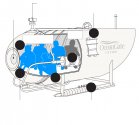"The odds are against them," Marquet said. "There's a ship in Boston that has this ability to either lower cable and connect to it or have a claw. It's still a thousand miles away."
Even if a vessel was able to locate the submersible and lower a cable, it's extremely difficult to safely navigate the waters and attach it, Marquet said.
"You've got to get it exactly right. It's sort of like ... getting one of those toys out of those arcade machines. In general, you miss," he said.
Rescuers do have one advantage, Marquet said, as weather conditions off the coast of Newfoundland are not rough and will not disturb any boat or vessel there.
Marquet said if the boat made it to the surface, the submersible crew would be able to open the hatch to allow for more oxygen while it was adrift.
Marquet told ABC that if the five people are still alive, they would be asked to sleep to conserve their oxygen.
"We would put the vast majority of the crew to sleep because that's when you're using the least amount of oxygen and you're expelling the least amount of carbon dioxide," he said.
The Pulse of NH is News Talk 98.1 WTSN on the seacoast, 107.7 WTPL in central NH, and 107.3 WEMJ in the Lakes Region. Home to Good Morning NH with Jack Heath.

thepulseofnh.com
















